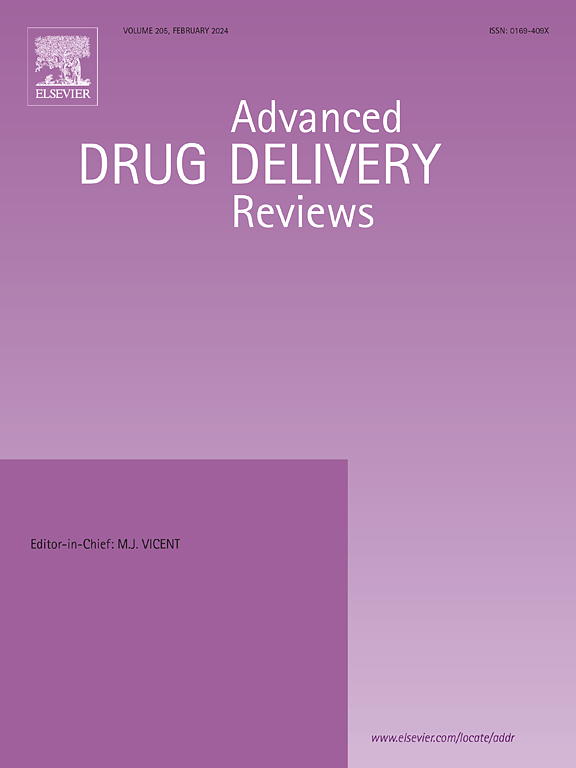靶向癌症治疗的光活性炭基纳米结构材料研究进展
IF 17.6
1区 医学
Q1 PHARMACOLOGY & PHARMACY
引用次数: 0
摘要
在这篇综述中,我们探讨了碳基纳米材料(CBNs)的光激活治疗编程的关键创新,重点关注其不同的纳米结构配置及其独特的光热、光化学和光声特性。这些特性使CBNs成为卓越的光治疗剂,通过其精确性、多功能性和对特定治疗方式的适应性,能够解决靶向癌症治疗中的关键挑战。我们将探索它们的各种衍生物,以及化学增强和位点特异性表面功能化的作用,这对于优化光疗干预的靶向性和有效性至关重要。这个不断增长的纳米材料库在靶向光疗中的生物和物理相关性将被彻底探索。动态光触发潜在的分子作用机制,如能量转换模式,是这些治疗创新的核心。我们将进一步讨论这些载流子的可调性和编程以及在特定治疗波长下的结构-功能改变。光疗的应用空间被彻底映射,探索光热疗法、光动力疗法和光化学内化的三种主要方法,以及结合两种或更多这些过程的新兴技术和有前途的多模式方法。靶组织部位的特异性和正在研究的方法形成了本综述的另一个关键焦点领域,重点是三种类型的癌症-乳腺癌,肺癌和胶质瘤-已经展示了一些最有希望的光医学结果。我们还提供了体外和体内验证以及CBNs用于光疗应用的临床前测试的观点。最后,我们通过数据驱动的材料设计和与生物物理性能优化计算工具的集成,反思了cbn在彻底改变靶向癌症治疗方面的潜力。机器学习与纳米粒子研究和光疗的令人兴奋的结合有可能从根本上改变纳米医学的格局。这些技术范围从监督学习算法(如随机森林和支持向量机)到更先进的神经网络和深度学习,可以在预测、优化和定制纳米颗粒特性方面实现前所未有的精度。光激活CBNs在推进癌症治疗方面的变革性影响,为其临床应用和在个性化光医学中的广泛采用铺平了道路。最后,我们总结了这些纳米结构材料的可重复性、制造吞吐量和生物相容性,包括它们在试验中的长期影响和在体外和体内评估的生物系统中的降解概况。本文章由计算机程序翻译,如有差异,请以英文原文为准。


Advances in photoactivated carbon-based nanostructured materials for targeted cancer therapy
In this review, we explore key innovations in photoactivated therapeutic programming of carbon-based nanomaterials (CBNs), focusing on their diverse nanostructural configurations and their exceptional photothermal, photochemical, and photoacoustic properties. These attributes position CBNs as remarkable phototherapeutic agents, capable of addressing critical challenges in targeted cancer therapy through their precision, multifunctionality, and adaptability to specific therapeutic modalities. We will explore their diverse derivatives, and the role of chemical augmentation and site-specific surface functionalisation, which are pivotal in optimising the targeting and efficacy of phototherapeutic interventions. The biological and physical relevance of this ever-growing library of nanomaterials in targeted phototherapy will be thoroughly explored. Dynamic photo-triggering of the underlying molecular mechanisms of action e.g., energy conversion modalities lie at the heart of these therapeutic innovations. We will further discuss the tunability and programming of these carriers and structure–function alterations at specific therapeutic wavelengths. The application space of phototherapies is thoroughly mapped exploring the three primary approaches of photothermal therapy, photodynamic therapy and photochemical internalisation as well as emerging techniques and promising multimodal approaches that combine two or more of these processes. The specificity of the target tissue site and the approach under study forms another critical focus area of this review, with an emphasis on three types of cancer—breast cancer, lung cancer, and gliomas—that have demonstrated some of the most promising outcomes from photomedicine. We also provide a perspective on in vitro and in vivo validation and preclinical testing of CBNs for phototherapeutic applications. Finally, we reflect on the potential of CBNs to revolutionise targeted cancer therapy through data-driven materials design and integration with computational tools for biophysical performance optimisation. The exciting integration of machine learning into nanoparticle research and phototherapy has potential to fundamentally transform the landscape of nanomedicine. These techniques ranging from supervised learning algorithms such as random forests and support vector machines to more advanced neural networks and deep learning, can enable unprecedented precision in predicting, optimising, and tailoring the properties of nanoparticles for targeted applications. The transformative impact of photoactivated CBNs in advancing cancer treatment, paves the way for their clinical application and widespread adoption in personalised photomedicine. We conclude with a section on the current challenges facing the reproducibility, manufacturing throughput, and biocompatibility of these nanostructured materials including their long-term effects in trials and degradation profiles in biological systems as evaluated in vitro and in vivo.
求助全文
通过发布文献求助,成功后即可免费获取论文全文。
去求助
来源期刊
CiteScore
28.10
自引率
5.00%
发文量
294
审稿时长
15.1 weeks
期刊介绍:
The aim of the Journal is to provide a forum for the critical analysis of advanced drug and gene delivery systems and their applications in human and veterinary medicine. The Journal has a broad scope, covering the key issues for effective drug and gene delivery, from administration to site-specific delivery.
In general, the Journal publishes review articles in a Theme Issue format. Each Theme Issue provides a comprehensive and critical examination of current and emerging research on the design and development of advanced drug and gene delivery systems and their application to experimental and clinical therapeutics. The goal is to illustrate the pivotal role of a multidisciplinary approach to modern drug delivery, encompassing the application of sound biological and physicochemical principles to the engineering of drug delivery systems to meet the therapeutic need at hand. Importantly the Editorial Team of ADDR asks that the authors effectively window the extensive volume of literature, pick the important contributions and explain their importance, produce a forward looking identification of the challenges facing the field and produce a Conclusions section with expert recommendations to address the issues.

 求助内容:
求助内容: 应助结果提醒方式:
应助结果提醒方式:


